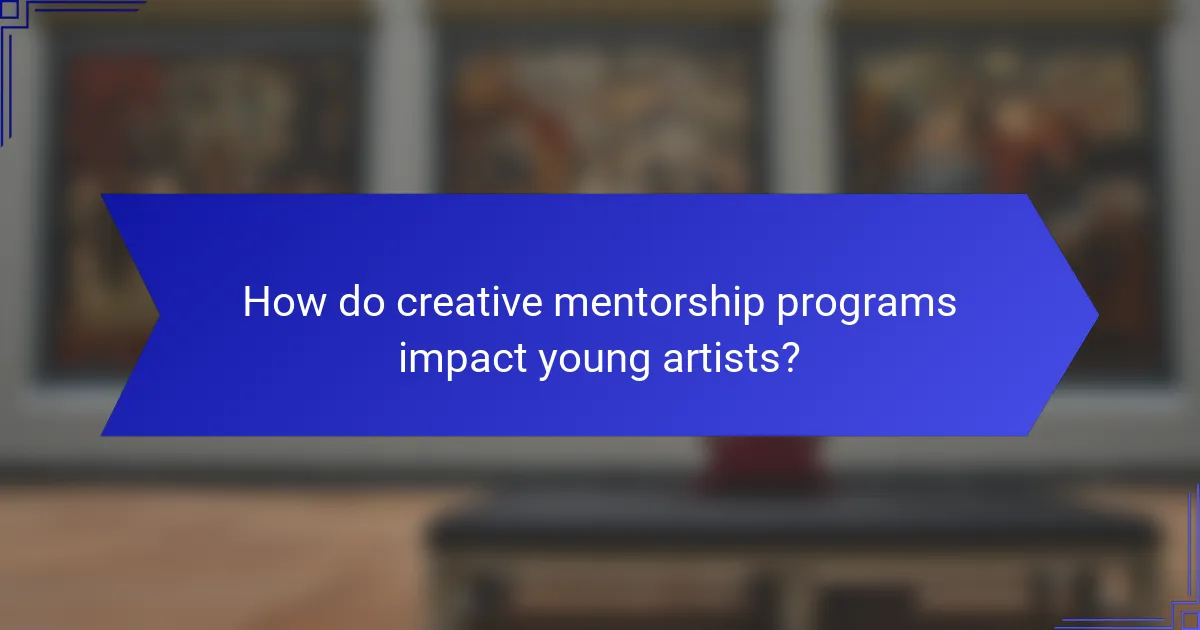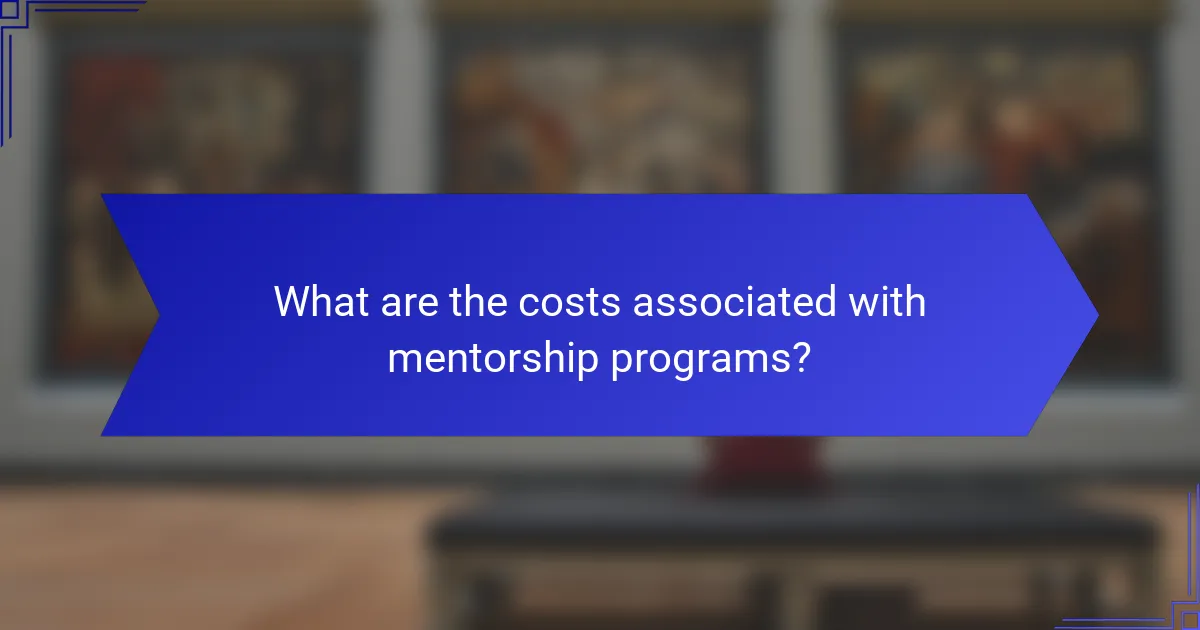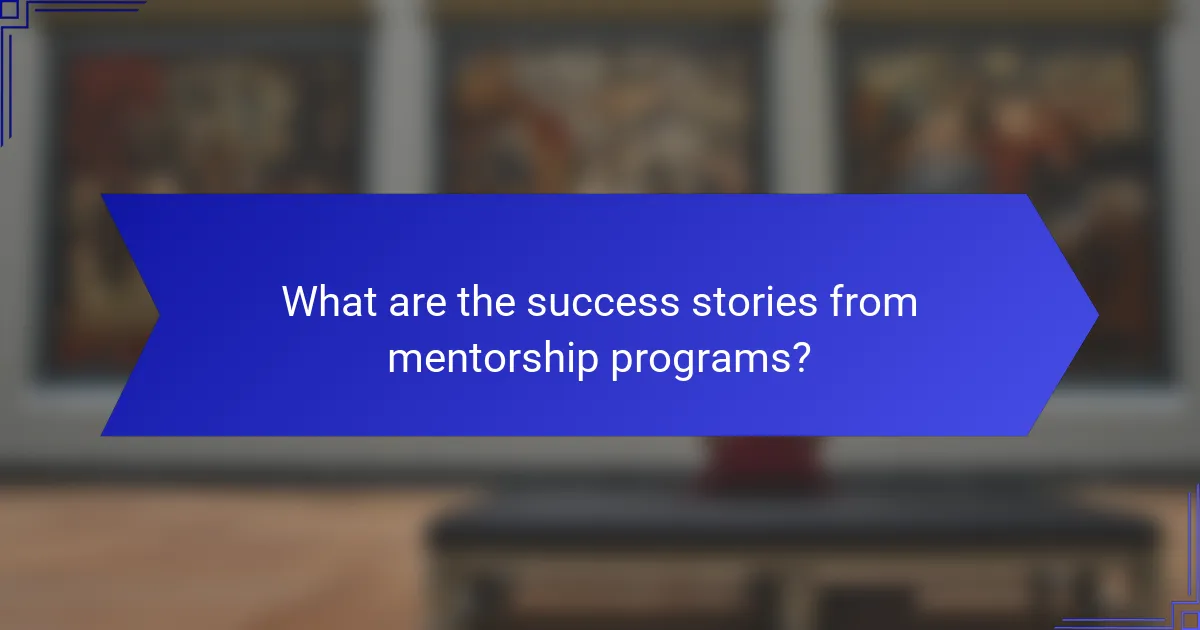Creative mentorship programs play a vital role in shaping the futures of young artists by offering essential guidance, resources, and support. These initiatives not only enhance artistic skills but also facilitate networking and boost self-esteem, which are critical for thriving in a competitive environment. By selecting the right program that aligns with their personal goals, young artists can unlock their full potential and navigate their creative journeys more effectively.

How do creative mentorship programs impact young artists?
Creative mentorship programs significantly enhance the development of young artists by providing guidance, resources, and support. These programs foster skill improvement, networking, and increased self-esteem, all of which are crucial for an artist’s success in a competitive landscape.
Skill development and artistic growth
Mentorship programs often focus on honing specific artistic skills, such as painting techniques, digital design, or performance arts. Participants receive personalized feedback and constructive criticism, which can lead to substantial improvements in their work.
Additionally, mentors may introduce mentees to new mediums or artistic styles, broadening their creative horizons. This exposure can inspire innovation and experimentation, essential components of artistic growth.
Networking opportunities
Creative mentorship programs provide young artists with valuable networking opportunities that can lead to collaborations, exhibitions, and job offers. Through organized events, workshops, and showcases, mentees can connect with established artists, industry professionals, and peers.
Building a professional network is critical for artists, as it often opens doors to funding, gallery representation, and other career advancements. Engaging with a community of creatives can also foster a sense of belonging and support.
Increased confidence and motivation
Participation in mentorship programs can significantly boost a young artist’s confidence. Receiving validation and encouragement from a mentor helps artists believe in their abilities and pursue their creative visions more boldly.
Moreover, the structured environment of these programs often instills a sense of accountability, motivating artists to set and achieve goals. This combination of support and motivation can lead to sustained artistic practice and long-term career development.

What are the best creative mentorship programs in the US?
The best creative mentorship programs in the US provide young artists with guidance, resources, and networking opportunities to enhance their skills and careers. These programs vary in focus, structure, and benefits, catering to different artistic disciplines and stages of development.
Creative Capital’s Mentorship Program
Creative Capital’s Mentorship Program connects emerging artists with experienced mentors in various fields, including visual arts, performing arts, and literature. Participants receive tailored advice, professional development resources, and access to a network of peers and industry leaders.
This program emphasizes the importance of building a sustainable career in the arts. Mentors help artists navigate funding opportunities, marketing strategies, and project management, ensuring they are well-equipped to succeed in a competitive landscape.
YoungArts Mentorship Initiative
The YoungArts Mentorship Initiative focuses on nurturing talented young artists aged 15 to 18 across multiple disciplines such as dance, music, visual arts, and writing. Selected participants receive personalized mentorship from established artists and industry professionals, along with access to workshops and masterclasses.
This initiative not only enhances artistic skills but also fosters personal growth and confidence. Young artists are encouraged to explore their creativity while developing a professional portfolio, which can be crucial for future opportunities in the arts.
ArtStart’s Mentorship for Emerging Artists
ArtStart’s Mentorship for Emerging Artists program is designed for individuals aged 18 to 30 who are looking to establish themselves in the creative sector. This program pairs participants with mentors who provide guidance on artistic practice, career development, and community engagement.
Participants benefit from hands-on experience and practical advice tailored to their specific artistic goals. ArtStart emphasizes collaboration and encourages emerging artists to connect with local communities, enhancing their visibility and impact in the arts scene.

How to choose the right mentorship program?
Choosing the right mentorship program involves evaluating your personal goals, the program’s structure, and the mentor’s qualifications. A well-suited program aligns with your artistic aspirations and provides the necessary support to foster your growth.
Assessing program goals and structure
Start by identifying what you want to achieve through mentorship. Look for programs that clearly outline their objectives, such as skill development, networking opportunities, or portfolio enhancement. A structured program with defined milestones can help you track your progress effectively.
Consider the format of the program as well. Some may offer one-on-one sessions, while others might include group workshops or online modules. Choose a structure that fits your learning style and schedule, ensuring it provides the right balance of guidance and independence.
Evaluating mentor experience and background
The mentor’s experience is crucial in determining the program’s effectiveness. Research their artistic background, including their achievements, teaching style, and industry connections. A mentor with a diverse portfolio and real-world experience can offer valuable insights and guidance.
Check for testimonials or reviews from previous mentees. This feedback can provide a clearer picture of the mentor’s approach and the impact they have had on others. Look for mentors who have a track record of helping young artists succeed in your specific area of interest.
Considering location and accessibility
Location plays a significant role in your mentorship experience. If the program requires in-person attendance, ensure it is conveniently located or offers remote options. Programs based in major artistic hubs may provide additional networking opportunities, but consider travel costs and time commitments.
Accessibility is also essential. Look for programs that accommodate different schedules and learning preferences, such as flexible hours or online resources. This ensures you can fully engage with the mentorship without it interfering with your other commitments.

What are the costs associated with mentorship programs?
Mentorship programs for young artists typically involve various costs that can impact participants’ budgets. Understanding these expenses is crucial for making informed decisions about enrollment and participation.
Tuition fees and scholarships
Tuition fees for mentorship programs can vary significantly, often ranging from a few hundred to several thousand dollars, depending on the program’s prestige and duration. Many programs offer scholarships or financial aid to help alleviate these costs, making it essential for applicants to research available options.
When considering a mentorship program, check the application deadlines for scholarships and ensure you meet any eligibility criteria. Some programs may require a portfolio or an interview as part of the scholarship application process.
Materials and supplies costs
Participants in mentorship programs may need to budget for materials and supplies, which can include art supplies, software, or other tools relevant to their artistic discipline. These costs can range from modest amounts for basic supplies to higher expenses for specialized equipment.
It’s advisable to inquire about what materials are provided by the program and what participants are expected to supply themselves. Creating a checklist of necessary items can help manage these expenses effectively.
Travel and accommodation expenses
Travel and accommodation costs can be a significant part of the overall expense for mentorship programs, especially if they require participants to relocate or travel frequently. Depending on the program’s location, these costs can vary widely.
Consider options for local housing or shared accommodations to reduce expenses. Additionally, some programs may offer stipends or assistance for travel costs, so it’s worth investigating these possibilities when applying.

What are the success stories from mentorship programs?
Mentorship programs have transformed the lives of many young artists, providing them with essential guidance and resources to thrive in their creative careers. These programs often lead to significant achievements, including awards, exhibitions, and successful artistic practices.
Notable alumni of YoungArts
YoungArts has produced a remarkable roster of alumni who have gone on to achieve great success in their respective fields. Notable figures include actress Viola Davis, musician Josh Groban, and visual artist Julie Mehretu. These individuals exemplify how mentorship can catalyze artistic development and career advancement.
Many YoungArts alumni have received prestigious awards, including Grammys, Emmys, and MacArthur Fellowships, showcasing the program’s impact on their professional journeys.
Impact of Creative Capital on careers
Creative Capital supports artists through funding and professional development, significantly influencing their career trajectories. By providing grants and resources, Creative Capital helps artists take risks and pursue ambitious projects that might otherwise be unattainable.
Artists who have received Creative Capital funding often report increased visibility and opportunities, leading to exhibitions, publications, and collaborations that enhance their professional standing.
ArtStart’s success metrics
ArtStart measures its success through various metrics, including participant engagement, project completion rates, and post-program achievements. Many participants report improved artistic skills and increased confidence in their work after completing the program.
Additionally, ArtStart tracks the number of alumni who secure grants, exhibit their work, or gain representation, providing a clear picture of the program’s long-term impact on young artists’ careers.